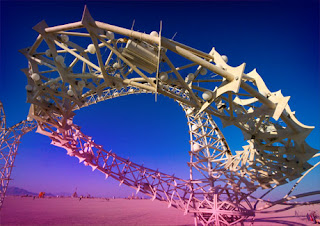Week Eight: Nanotechnology + Art
At
first, I found this week's topic of nanotechnology harder to connect to art,
even though past weeks have included equally scientific connections. I found
that Dr. Gimzewski's lectures struggled to make the connections to art
naturally, but as I watched the videos, I personally began to find the art in
nanotechnology. There is something about viewing things on a microscopic level
that makes things so beautiful. When Dr. Gimzewski spoke about the
nanotechnology affecting clothing, I looked into the pictures of fibers. The
Mincor brand is designing fabrics that still breath while also wicking away
liquids, which utilizes innovative technology to reduce the necessity to clean
clothes nearly as often. (BASF Chemical Company) The nanotechnology, when blown
up, looks like intricate basket weaving and is utterly beautiful. I also found
the intricate structure of atoms and contour maps especially striking. Contour
maps and coloration are being used in nanotechnology to determine the shapes of
surfaces on molecular levels and even the sizes of cells relative to other
neighboring cells.
 Most
fascinating to me personally was the work being done in relation to the medical
field. Scientists are developing nanorobots that have an extraordinary
potential to be life-saving. Pictured on the Nanomeme Syndrome site is a
nanorobot grasping viral particles, presumably in order to transport them out
of the body in a manner as to leave a person unharmed from disease. This idea
emphasized where art came into play with technology. When imagining these
particles, the nanometer's unit of measurement is arbitrary. The things that we
are seeing might as well be invisible, hardly describable even via microscopes.
We, "immediately reach the limits of rational human experience, and
the imaginary takes over" in attempting to draw and feature these minute
particles. (Gimzewski et al.)
Most
fascinating to me personally was the work being done in relation to the medical
field. Scientists are developing nanorobots that have an extraordinary
potential to be life-saving. Pictured on the Nanomeme Syndrome site is a
nanorobot grasping viral particles, presumably in order to transport them out
of the body in a manner as to leave a person unharmed from disease. This idea
emphasized where art came into play with technology. When imagining these
particles, the nanometer's unit of measurement is arbitrary. The things that we
are seeing might as well be invisible, hardly describable even via microscopes.
We, "immediately reach the limits of rational human experience, and
the imaginary takes over" in attempting to draw and feature these minute
particles. (Gimzewski et al.)
These
aspects of nanotechnology immediately reminded me of Week Six's BioTech +
Art theme, thereby again raising ethical questions. How will nanotechnology that
affects health be tested? What could be possible potential consequences of
eradicating diseases? Ray Kurzweil discussed that this technology, no matter
our economic state, will continue to increase exponentially. Even when we hit
one wall in tech, another hurdle is overcome and a new paradigm introduced.
With each hurdle, I believe, nanotechnology is not only pushing the limits of
how we can affect humanity but also the artistic limits of our imagination in
attempting to diagram exactly what we are (and aren’t) seeing.
Sources:
Gimzewski, Jim. Nanotech for
Artists Pt. 1 https://cole2.uconline.edu/courses/684222/pages/unit-8-view?module_item_id=11226175
Gimzewski, Jim. Nanotech for
Artists Pt. 2 https://cole2.uconline.edu/courses/684222/pages/unit-8-view?module_item_id=11226175
Gimzewski, Jim. Nanotech
for Artists Pt. 3
https://cole2.uconline.edu/courses/684222/pages/unit-8-view?module_item_id=11226175
Kurzweil, R. (Feb 2009). A
University for the Coming Singularity [Video file]. Retrieved from
https://www.ted.com/talks/ray_kurzweil_announces_singularity_university.
"LSD: A Short
History." DrugFreeWorld.org. Drug-Free World, 2017. Web. 20
May. 2017.
"Mincor TX TT Textile
Coating." AskNature.org. BASF Chemical Company, 10 Aug
2015. Web. 27 May 2017.
"The
Nanomeme Syndrome: Blurring
of fact & fiction in the construction of a new science." Arts.Ucla.org. Gimzewski,
Jim; Vesna, Victoria.
Pictures:
Gimzewski, Him. Digital
Image. Arts.Ucla.edu. http://vv.arts.ucla.edu/publications/publications/02-03/JV_nano/JV_nano_artF5VG.htm
Industrial Fabrics Association
International. Digital Image. IFAI.com. http://www.ifai.com/0708_ft1_1/.
Johnson, Jeff. Digital Image from Video file, 2001. “Nanotech for Artists Pt. 2.”
Johnson, Jeff. Digital Image from Video file, 2001. “Nanotech for Artists Pt. 2.”




Jennifer,
ReplyDeleteI also found that this week was a little harder to connect to art, however I still enjoyed learning about nanotechnology, considering I did not know much about it previously. I like you're interpretation that once you look at something on a microscopic level it itself is beautiful and can be considered an art form. I did not think about viewing organisms at a microscopic level to be art. Even though it was harder for you to connect art with nanotechnology from the lecture's, it seems you were still able to display an interest in it and understand the topic.
Hi Jennifer,
ReplyDeleteI too found the topics of nanotechnology and art disconnected at first. I also wanted to write my post about incorporating nanotechnology into clothing. As a person who absolutely despises doing laundry, I definitely find myself wanting to learn more about this type of clothing. I found your statement regarding how intricately beautiful the contour maps and coloration that are nanotechnology very true. I think that nanotechnology is impressive because it allows us to see things that are not visible to the naked eye. As nanotechnology continues to advance in all different fields, the opportunities are endless.